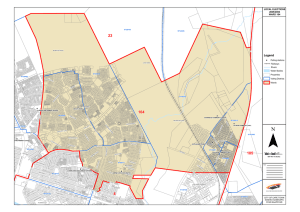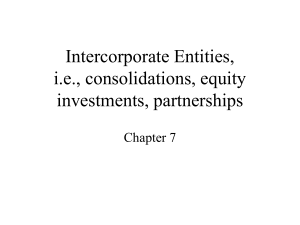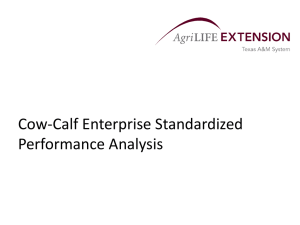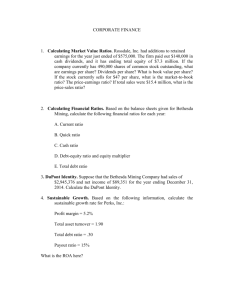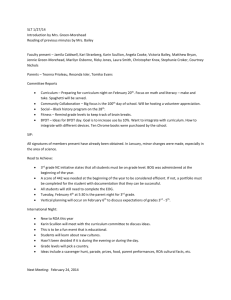Cow-Calf Costs and Necessary Calf Price for Target ROA
advertisement
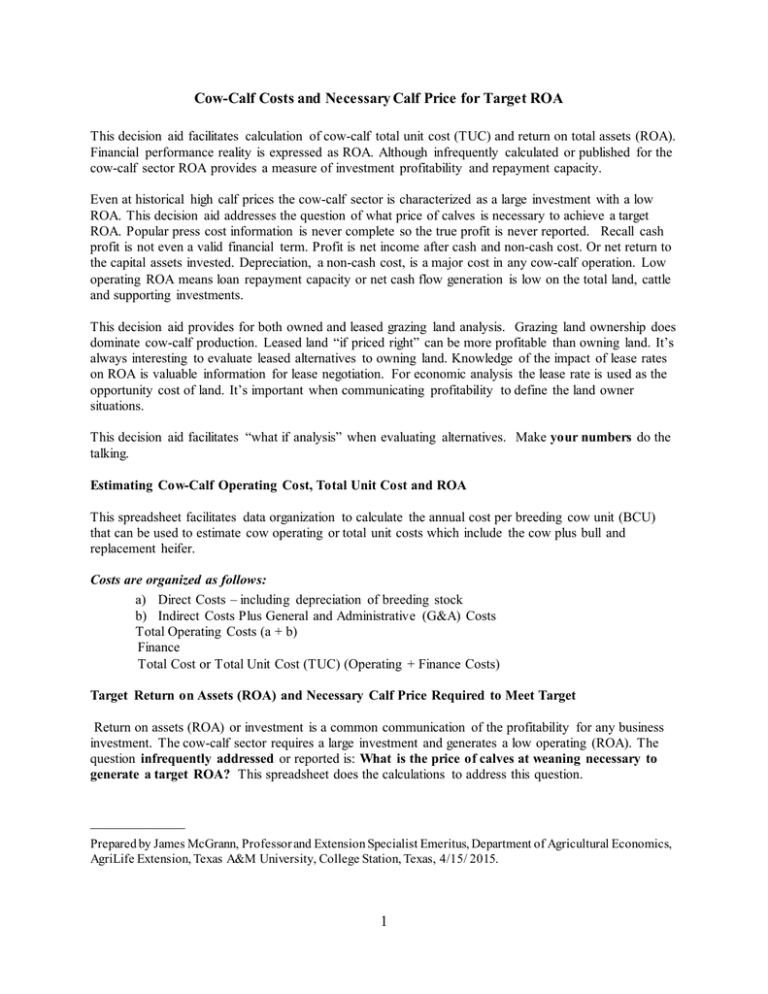
Cow-Calf Costs and Necessary Calf Price for Target ROA This decision aid facilitates calculation of cow-calf total unit cost (TUC) and return on total assets (ROA). Financial performance reality is expressed as ROA. Although infrequently calculated or published for the cow-calf sector ROA provides a measure of investment profitability and repayment capacity. Even at historical high calf prices the cow-calf sector is characterized as a large investment with a low ROA. This decision aid addresses the question of what price of calves is necessary to achieve a target ROA. Popular press cost information is never complete so the true profit is never reported. Recall cash profit is not even a valid financial term. Profit is net income after cash and non-cash cost. Or net return to the capital assets invested. Depreciation, a non-cash cost, is a major cost in any cow-calf operation. Low operating ROA means loan repayment capacity or net cash flow generation is low on the total land, cattle and supporting investments. This decision aid provides for both owned and leased grazing land analysis. Grazing land ownership does dominate cow-calf production. Leased land “if priced right” can be more profitable than owning land. It’s always interesting to evaluate leased alternatives to owning land. Knowledge of the impact of lease rates on ROA is valuable information for lease negotiation. For economic analysis the lease rate is used as the opportunity cost of land. It’s important when communicating profitability to define the land owner situations. This decision aid facilitates “what if analysis” when evaluating alternatives. Make your numbers do the talking. Estimating Cow-Calf Operating Cost, Total Unit Cost and ROA This spreadsheet facilitates data organization to calculate the annual cost per breeding cow unit (BCU) that can be used to estimate cow operating or total unit costs which include the cow plus bull and replacement heifer. Costs are organized as follows: a) Direct Costs – including depreciation of breeding stock b) Indirect Costs Plus General and Administrative (G&A) Costs Total Operating Costs (a + b) Finance Total Cost or Total Unit Cost (TUC) (Operating + Finance Costs) Target Return on Assets (ROA) and Necessary Calf Price Required to Meet Target Return on assets (ROA) or investment is a common communication of the profitability for any business investment. The cow-calf sector requires a large investment and generates a low operating (ROA). The question infrequently addressed or reported is: What is the price of calves at weaning necessary to generate a target ROA? This spreadsheet does the calculations to address this question. ______________ Prepared by James McGrann, Professor and Extension Specialist Emeritus, Department of Agricultural Economics, AgriLife Extension, Texas A&M University, College Station, Texas, 4/15/ 2015. 1 Land Owned or Leased Land Options Two land ownership options are included in the decision aid: 1. Owned land and improvements 2. Leased land. The land ownership costs include land tax and maintenance of land and improvements including items like weed and brush control or an intensive system using fertilizer and lime. For leased land in addition to cash lease the tenant may be required to pay maintenance costs as part of the full lease cost. In the spreadsheet the user can define the lease payment options. If on a per acre basis the number of acres is for a BCU. Calculating ROA in the owned land option includes the market value of the land and improvements are included in the total investment per BCU. The appreciation of the land is not included in the calculation of the annual operating ROA. Of course land appreciation is only realized when the land is sold. Calf Price Premium There are a number of branded beef or value added programs that provide a premium price to producers that produce calves that will fit their specific program requirements. It is always a question if the programs offer sufficient price increase to offset added cost of compliance. This decision aid provides for recording the premium and calculating the impact on the revenue and actual ROA for the participation. If there are added costs the costs can be added in direct costs. Operation of the Spreadsheet All values in blue are variables and are unprotected for data entry. First time users should read the definitions before starting data entry. This spreadsheet requires a lot of data but it’s worth the effort as once set up only select variables like current prices need to be changed to evaluate alternatives. Be sure and review the definitions that follow to help clarify the meaning of results. As with any decision aid the results calculated are a product of the quality of data used. Good records on feed use, cattle inventories and reproduction will provide the data for accurate projections. Using classes in QuickBooks™ will provide good data for calculating TUC. You have to have your own data! When evaluating results be sure and do “what if” analysis on the items that are important such as weaning rate, breeding productive lives and grazing and feed costs. Viewing family living withdrawals can be a guide to owner operator compensation. In sheet 1 the annual costs are recorded and the percent the different cost items account for as a percent of total cost is important information to keep costs in proper perspective. For example, the veterinary, health and breeding including herd bull depreciation is less than 10% of TUC. Any savings in this area that would lead to a lower crop is “bad economics”. Reduced revenue is greater than cost savings. It’s good to evaluate both owned and leased land in sheet 1. In sheet 2 it’s notable the sensitivity the necessary calf price change is required to a changing target ROA. High grazing lease rates and land values mean low operating ROA for the cow-calf sector. Recall land appreciation is not included in calculating ROA. Productive years of cows and bulls are important to calculate the replacement rate and depreciation cost. Recall it’s not based on the oldest cows or bulls but the average number of productive years. Many cows and bulls go out early in life and this reduces the number of productive years. Complete cow records often have herd average of 5-6 productive years. 2 There is a list of definitions of Standardized Performance Analysis (SPA) guide calculation of the weaned calf crop or weaning rate. Recall weaning rate is based on exposed females. Sheet 3 reports price of steer separate from heifers while maintaining the price difference between steers and heifers to facilitate comparing market data to the calculated results. The calf price necessary to cover TUC is after cull revenue and calf buyer premium is subtracted from TUC. Calf prices lower than these calculated values means that ROA is negative. Costs are greater than revenue. Key Cost Definitions: Direct Expenses are expense items that are directly related to production activity such as grazing, stored feed, veterinary and medicine or health, and hired and owner labor and management costs. There is management time spent on planning, tax and other compliance issues, implementation and marketing issues. Indirect Costs are the costs of asset ownership and operating costs. Depreciation or capital asset recovery, repair, maintenance of the vehicles, machinery and equipment, labor and management, utilities, property tax are examples of operating costs. General and administrative costs are indirect costs that all businesses incur to cover bookkeeping, professional fees, insurance, office supplies, computer services, phone and other utilities. Owner Operator Labor and Management compensation should be included in the production cost calculation at a level equivalent to the salary required to hire a non-family member to provide an equivalent service. Owner manager costs need to be included in production costs. Not including owner managers cost implies the owners work for nothing. Depreciation is the value that accounts for the use of a capital asset over time or its useful life. The IRS depreciation schedule because of IRS rule defined economic life and zero salvage value is not a reasonable measure of depreciation. The depreciation schedule can be set up to use a more appropriate useful life and salvage value for vehicles, machinery, equipment, improvements and purchased breeding stock. The CPA can run a “book depreciation” in addition to the IRS depreciation. Finance Cost is the actual interest paid to finance debt associated with the production activity. Operating Costs are the sum of the direct and indirect costs. This cost is incurred in the production process. Operating costs added to finance are the total unit costs (TUC). Raised Replacement Heifer Cost is not addressed in this simple decision aid. For simplification purpose values all females’ replacements and cows are the same and depreciation is a current production cost. In other words it is as if replacements are purchased. All heifer calves are priced as market value. Total Unit Cost of Production (TUC) is the total cost of production which includes direct, indirect and finance costs. This cost can be compared to product price to evaluate the competitiveness of the enterprise. At this price, total enterprise revenue is exactly equal to total enterprise costs, which results in zero net income. It’s a business no equity growth situation only covering TUC. 3 Key Financial Definitions: Return on Assets (ROA). This ratio is an indicator of how productive the assets are being used by the enterprise. This percentage is calculated as net income from operations divided by total assets. Finance or interest paid is not included in total costs as interest represents a return to the debt capital. ROA is a return to capital invested irrespective of capital ownership. ROA is the net income generated by all assets, after labor and management have been compensated, divided by assets. ROA indicates the profitability per dollar of assets, thus allowing comparisons over different size firms and different types of businesses or investments. The business balance sheet at market value reports total assets. Profit (Loss) - Great care must be exercised in reading reports in the cattle sector labeled as profit or loss. Most frequently in feedyard, cow-calf or other cattle reporting, these numbers are gross margins (gross revenue minus direct costs) and do not include overhead and owner labor and management costs, which are required to calculate a true profit or return to business equity. Cash to cash reported margins are not profit as it does not include depreciation, a non-cash cost, or the profit (loss) associated with use of the futures market or other price risk management strategies for feed or cattle . Breakeven Cost is a cost component divided by the amount of saleable product. The costs included must be defined before a breakeven can provide useful information to a decision maker. A break-even that does not cover full cost (TUC) is very misleading. Feedyards never calculate a “full cost” breakeven. It is a feedyard direct cost breakeven. Producers must add to direct costs full cost and the business’s general and administrative (G & A) and finance costs. Producers must have total unit cost (TUC) to have a true measure of profitability. Having G&A and actual interest cost will mean the cattle profitability and TUC are consistent with the total business income statement or profit and loss (P&L) statement. Key SPA Reproduction Definitions for Numbers and Calculations 1. A total female exposed at the beginning of the breeding season is the number of females in the beginning inventory that are exposed either to bulls or in an artificial insemination (AI) program. The number should correspond to the number on the beginning date of the breeding season. 2. Adjusted exposed females including sales, transfers, purchases of pairs and exposed and pregnant females -- is an inventory of exposed females that results from the beginning inventory plus all the adjustments. This is the most critical number that must be generated by the inventory in the reproduction and production performance measures of the cow-calf enterprise. The accuracy of this value will determine the overall accuracy of the productivity analysis. The key is to carefully monitor monthly inventory maintenance and consistency between operating cycles. This number begins with the beginning inventory on day one of the breeding season, subtracts culls not intended to be bred, as well as sales or transfers out of the breeding herd and adds purchases or transfers in. The net result is used to determine the weaned calf percentage and other production measures of performance. 3. Number of exposed females that are pregnancy tested will be the base number used to calculate the pregnancy rate after adjustments. Includes females which were pregnancy tested and sold or transferred out after the breeding season. 4 4. Number of females diagnosed as pregnant is the actual number of the exposed females diagnosed as pregnant. The accuracy of the pregnancy rate improves when all females that are exposed are pregnancy tested. Includes females which were diagnosed as pregnant, but sold or transferred out of the breeding herd after the breeding season. 5. Pregnancy percentage -- expresses the number of females diagnosed as pregnant as a percentage of the number of exposed females that are pregnancy tested. 6. Number of females diagnosed as open is the number of females diagnosed as not being pregnant or the total number pregnancy tested minus those diagnosed as being pregnant. Includes females which were diagnosed as open but sold or transferred out of the breeding herd after the breeding season. 7. Pregnancy percent based on exposed females is the key SPA measure and is the number of pregnant females divided by the adjusted number of exposed females (see definitions 1. and 2. 8. A pound weaned per exposed female is a very important measure of performance for producers selling weaned calves. It is calculated by multiplying weaning percent by average weight. Combining weaning weight and reproduction truly measures production. References: SPA information see the web site http://agrisk.tamu.edu - Select from menu and select Beef Cow-calf Ranch Economics and analysis. Texas A&M University, Department of Agricultural Economics, Software Tools: Extension Agricultural Economics, Beef Cattle Decision Aid Software http://agecoext.tamu.edu/resources/software-tools/ 5
